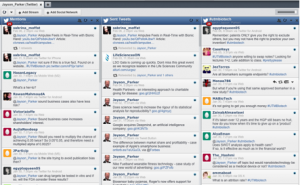Jayson Parker
 |
COURSE: BIO375H, Intro to Med Biotech DEPARTMENT: Biology INSTRUCTOR: Jayson Parker LEAD DEVELOPER: Jayson Parker |
SYNOPSIS OF COURSE: Introductory Medical Biotechnology (3rd year undergrad). Focus is on how new medicines, including drugs, medical devices and related software, are validated and get to market. This involves science, business and regulatory elements.
The goals of the course are to raise awareness among students of how new medicines are developed, the range of employment opportunities in the sector and the skills required. Students have to be able to apply the course content critically to problems in industry.
Ancillary goals of the course are to engage students in writing essays and applying their statistical training to actual problems. In addition, I want students to work in teams and develop their presentations skills (despite a class size of 150).
YOUR KEY TEACHING AND LEARNING OPPORTUNITIES/CHALLENGES WHEN DESIGNING THIS COURSE:
- How do I maximize class discussion in a large class?
- How can I encourage students to develop their communication skills and take them seriously?
- How can encourage students to tackle problems in creative ways, drawing upon knowledge from their entire degree, not just this course?
- How can I create a classroom of energy and enthusiasm about the course content?
- How can I inspire students to see the content as fun?
YOUR DESIGN SOLUTIONS:
- Engaging the class for discussion. Social media is used for 2 reasons: it is a scalable technology for this purpose — as class size increases it allows students anonymity when they interact, which can help foster participation in a large class. Class participation is based on students sending answers / questions to the instructor’s Twitter account (no grade for answers, just for whether they participate – they can choose to opt out). Per hour the instructor receives about 50 Tweets, either as answers or questions. Tweets can also be reviewed outside class time, to see if key questions posed were missed that should be addressed next class. The second element of social media used in the class is the instructor’s Tweets (“sent Tweets”) – which is testable material in the course. The third social media element is a course hashtag (e.g. #UTMBiotech) which is available for the students to use and is not part of participation nor monitored. The hashtag is projected on a second screen during lecture (the first projector screen is for slides). Students see the hashtag in which they can ask for notes from each other, or pose questions or answers.
2. Communication skills. There are 2 assignments or deliverables: a 4 page formal essay and a video presentation. The essay is short but gives a good indication of whether students can structure formal arguments in an essay. The second assignment/deliverable is a 10-minute presentation by a each team of students working on their major project. Students are able to opt out but choose to take the challenge. No technical support is provided yet all student teams create video presentations of their team by using their laptop camera and some video editing. Students seem to rise to this challenge, showing great creativity. Despite no technical support, not a single team has declined this assignment and choose an alternative. Team videos are uploaded to a drop box folder dedicated to the course, which can handle the memory demands of 20 team videos. Videos are viewed offline by the instructor and his teaching assistant.
3. Creative Problem solving. A team based learning approach is used. There are 5 tutorials, each 1 hour, where student teams are confronted with a single slide of content and one question. The problem is introduced without any narration by the instructor – the slide speaks for itself. The sound track for Mission Impossible is played, during the introduction of the problem to provide another modality to engage students. They have 40 minutes to compose an answer to the problem and then email their response to the instructor. They posed problems are broad with a range of potentially valid answers, depending upon how well they are justified. The posed problems force students to draw upon the current course and other courses at the undergraduate level. 20 teams of students work on these problems and the instructor and the TA float around the room visiting teams as they work through their problem. At 40 minutes, when all emails from teams have been received, we take up the problem.
4. Classroom energy. For classes with tutorial sessions, the tutorials start by introducing the problem with the Mission Impossible soundtrack playing. For all other classes not involving a tutorial, the lecture starts using the “Star Wars” floating text to introduce the concept of the lecture. As the floating text in the Star Wars trailer is displayed, the sound track for the opening credits of Star Wars is also played. This sequence takes about 90 seconds but does much to take hold of student attention. A final element that is used, that was challenging to set up – is that the entire lecture is given from my iPad. I can move through the entire lecture hall, visiting each area of students. While I move I control the slides and video with my iPad. There is a built in laser pointer in the iPad given the touch screen, so this is fun for both the instructor and the students.
5. Class fun. A lot of this is encouraged by elements described in the above – Twitter use, Mission impossible sound track, creating course videos, iPad controlled lecture environment, Star Wars trailers to introduce new lecture content. One of the course concepts is the practical relevance today of “artificial intelligence”. To this end, in lecture I would use Apple’s “Siri” – an advanced voice recognition program – to launch apps on my iPad. Fun for students to see, but also reinforces one of the lecture topics in the course. The app I use on my iPad allows me to draw most things I would normally use a chalkboard for – and I can email / post the image to the class in addition to showing it on the projector.
YOUR BIGGEST “TAKE AWAY” FROM THE COURSE DESIGN INSTITUTE?
My biggest takeaway was that I cannot ask students to behave a certain way on an exam if that is not part of the same preparation and demands incorporated into lectures/class time and in assignments. Expectations have to be consistent throughout the course. I can’t expect students to think critically and creatively on course assignments, if I don’t give them the chance to practice that in both tutorials and lectures/class activities. All behavior I wish to see in students has to be part of the course design.
DID YOU SEEK ADDITIONAL SUPPORT IN TERMS OF DESIGNING YOUR COURSE? WHAT HELPED YOU?
- I had major support from from our Audiovisual team and the library on the use and technical implementation of social media use, iPad controlled lecture hall and drop box for course uploaded videos.
- I also had extensive support from Apple computer to set up the Star Wars trailers and to learn how to edit videos for lecture content in the course.
YOUR NEXT STEPS:
- Teams are new for many science students – so handling “social loafers” in such groups or managing group size in the face of late course drops is a current challenge.
- The hashtag on the second monitor is a new feature I added in the 2nd year offering the course – it looks useful – continuing to monitor its practical contribution to the class.
- I may explore Tumblr as a tool to create external educational sources for the course.
TESTIMONIALS:
- The course design institute challenged me to deliver a highly polished course.
- The course design institute has attuned me to the importance of ensuring skills and habits taught/practiced in lecture and tutorials are the same I ask students to demonstrate on exams and major projects.




